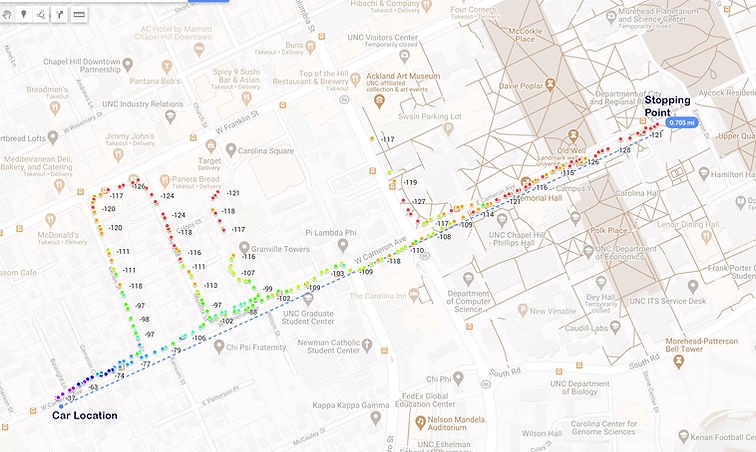How far will it go?
Sometimes you just want to keep your pet in the car while you shop - and the range isn't important. Other times, you may be inside an arena or working on the 10th floor and wonder if the Heat Guardian can reach that far.
Below this discussion are three real-life tests of range.
Top line
Almost all of the time the Heat Guardian will reach at least one city block. In a clearing it will reach about a mile.
Compared to other technologies
Here's a useful chart to examine. Heat Guardians use the patented LoRa technology.

Detail
There are a number of factors that affect how far a Heat Guardian can send. Imagine a straight line between the two antennas. The most important factors are
- Objects between the two antennas (on the straight line).
- Type and orientation of the antenna
- Power output
Objects between the two antennas
Solid objects act like slightly-translucent walls for radio waves - they can block a lot of radio. An 8" solid concrete wall, like a bomb shelter for example, will cut the range by 94%. Metal and concrete walls are bad, trees are not great. Glass and plastic are almost transparent to radio.
So, what is between the two antennas matters a lot. Radio can ooze around objects, but it will still affect the range.
Type and orientation of the antenna
Different-shaped antennas work different ways. Some get great range in only one direction while others get mediocre range but are omnidirectional.
The antenna shapes on the Heat Guardian are carefully designed. The loop antenna in the handle is primarily an omnidirectional horizontal antenna but it has some directionality from the loop shape.
Since the antenna is slightly directional with the loop it can be tuned for a bit more range if you have to by rotating the unit so the loop is perpendicular to the path.
Power output
The FCC specification for the Heat Guardian radio dictates that it can only transmit up to about 1/4 Watt in the US – less in the EU. The physical radio itself has an upper limit at about 1/4 watt. We’ve found that reliability of the radio chip improves at 0.1 W (20dBm) – so that’s the default power level of the Heat Guardian.
Real Life Tests
The following tests were taken with a Heat Guardian around our office in Chapel Hill, North Carolina. The monitor unit had an attached GPS so it could log position and signal strength.
Signal power level is historically shown as a negative number (in dBm). The smaller the number the lower the power received. So, for example, -52 power is greater than -70 power.
The lowest signal level that can be received with the Heat Guardian is about -135. The lowest signal level that can be measured is -128. The radio can receive signals below atmospheric noise - which is typically from lightning somewhere on Earth!
The signal level is shown as labels on the points and the color tells how close to failure (purple then blue then green then red) they are. If the radio did not receive anything then there is no bubble shown.
Downtown Walkthrough
In the first image, I take a walk in downtown Chapel Hill, NC with the Heat Guardian Sensor in the back of my parked car (sending through the rear window) and the Heat Guardian Monitor in my hand. Moderately large brick buildings occupy most of the area. The road was selected because it is very flat.
I stopped walking at 3/4 mile because the road was taking a serious down-hill bend and it was enough info - there was still a bar left, though.

Suburb Walkthrough
The following image shows reception in a hilly neighborhood. The car was left with the Heat Guardian Sensor in the grocery store parking lot of a small shopping area. The farthest north on the map is higher in elevation.

Woodlands Hike
The below image is a hike through a forest area. Here the Heat Guardian barely reaches 0.4 miles. The Google Maps photo looks ‘scrubby’ but the woodlands are very thick in the late summer when tested.

